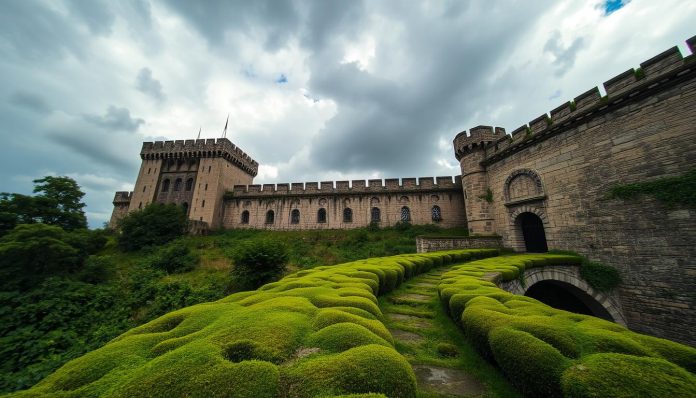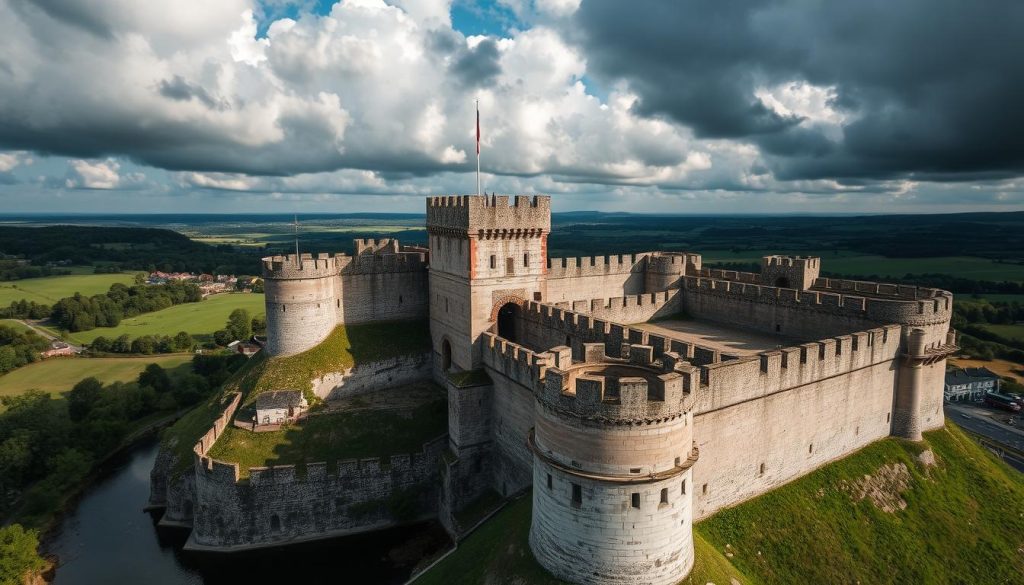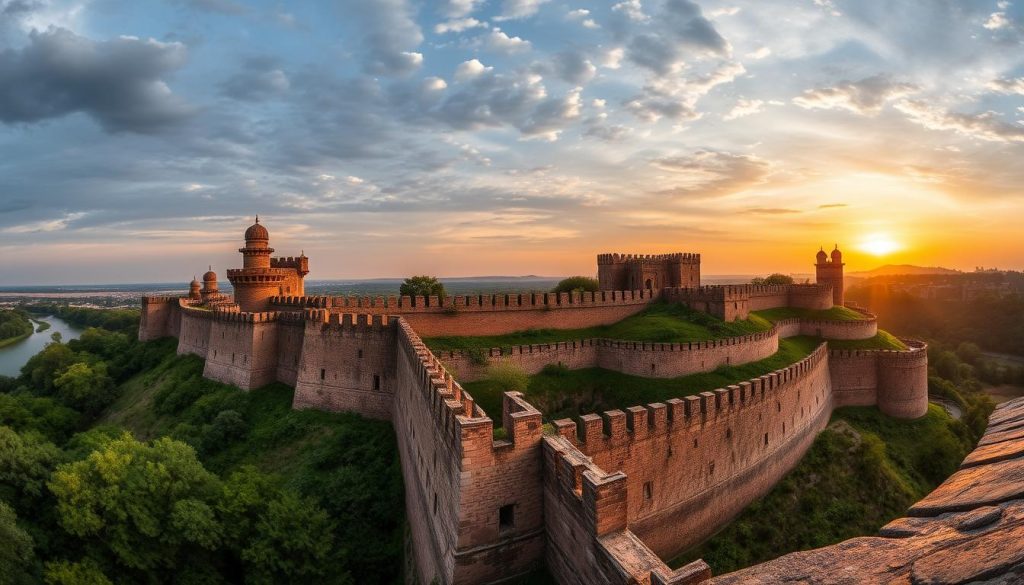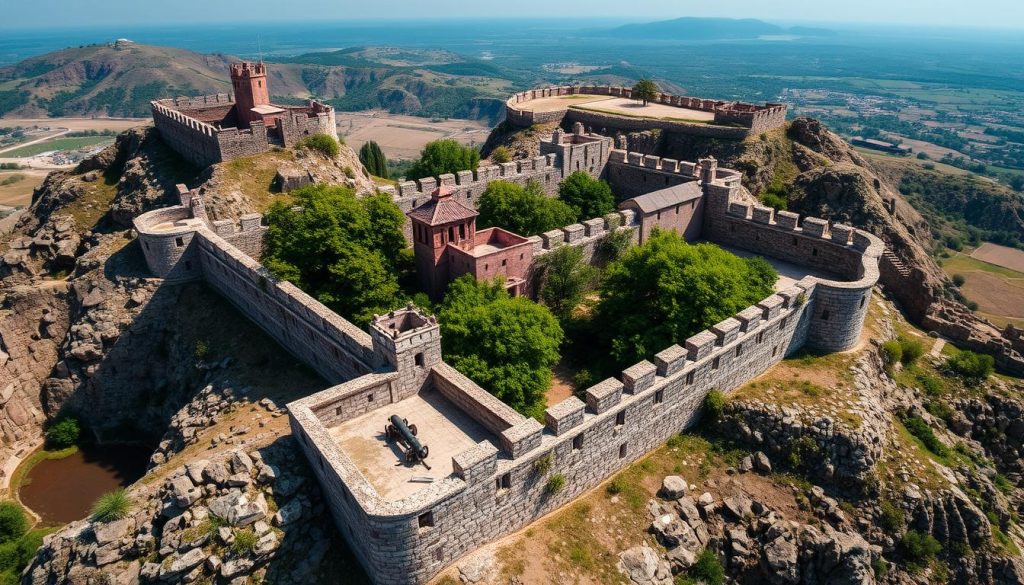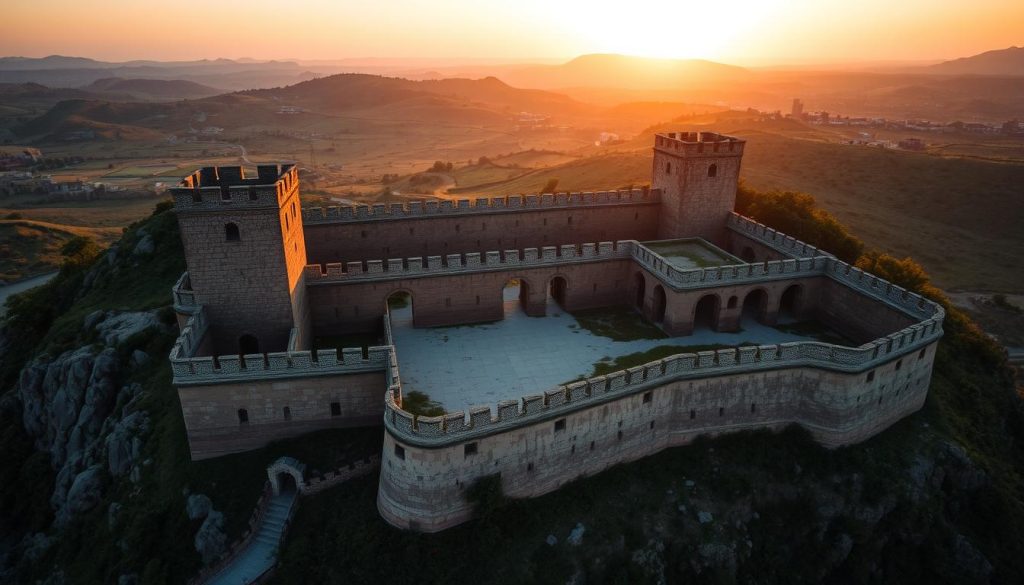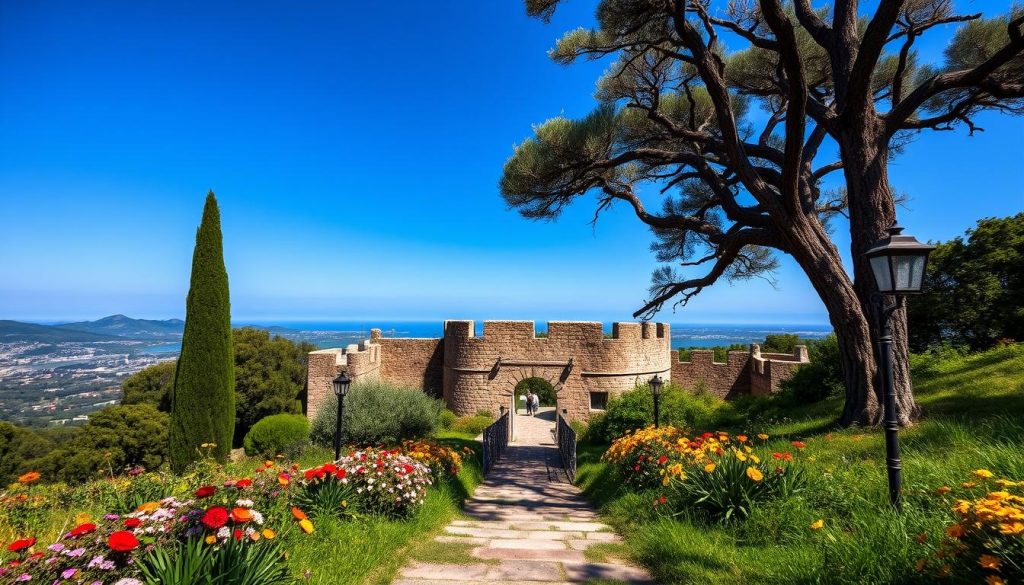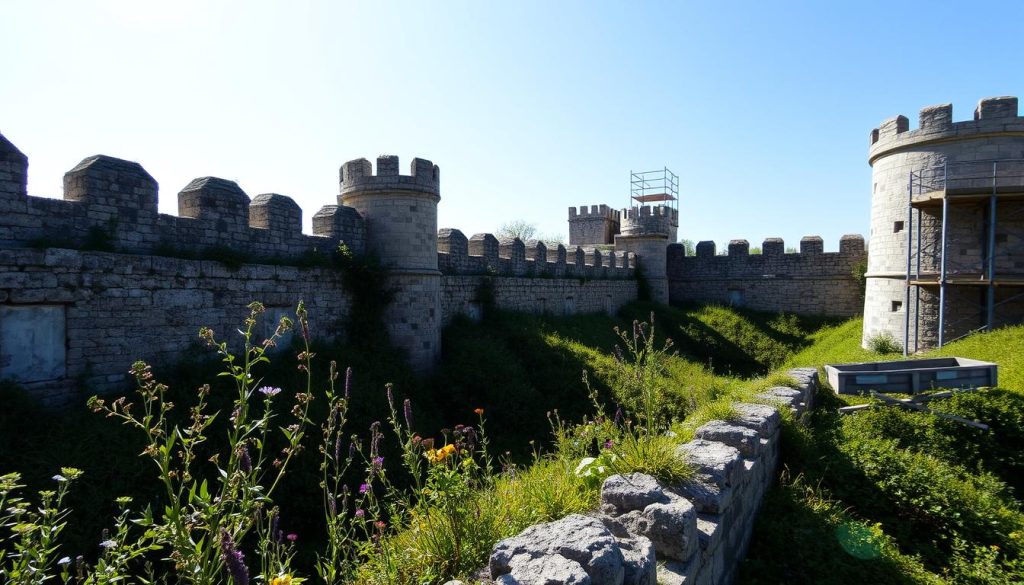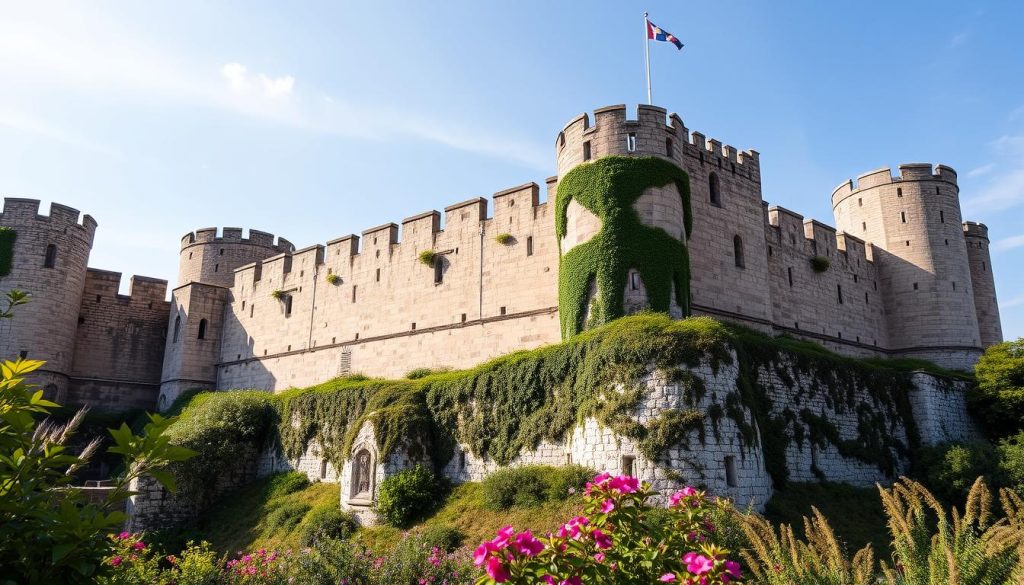Ever wondered what’s hidden beyond the grand gates of old defenses? The main gates of fortresses get all the attention, but there’s more. Beyond these gates, you’ll find engineering marvels that support these strongholds. These fortifications and bastions are key to understanding medieval architecture and military history.
Let’s explore these hidden gems. They not only strengthened defenses but also influenced warfare and security. Join us as we uncover the secrets of these remarkable structures.
The Importance of Fortifications in Military History
Fortifications have always been crucial in military history. They act as barriers against invaders and show the culture and economy of their time. These structures come in many designs and materials, each telling a story of history.
Defining Fortifications and Their Historical Context
Fortifications have many roles in warfare. From ancient walls to modern bunkers, they’ve changed with culture and technology. They were built to meet specific military needs and threats.
Features like moats and ramparts were key in defense. As military tactics evolved, so did fortification designs. This kept them effective in each era.
Military Strategies and Architectural Innovations
Architectural innovations have shaped military strategies over time. New technologies in fortification designs show a constant exchange between warfare and architecture. For example:
- Angled walls to deflect cannon fire.
- Bastions for better field of fire.
- Fortifications near trade routes and resources.
These innovations show military genius and improved fortification effectiveness. They highlight the vital role of fortifications in military history.
| Period | Key Innovations | Strategic Impact |
|---|---|---|
| Ancient | Stone walls, Moats | Basic protection against infantry |
| Medieval | Bastioned forts, Watchtowers | Enhanced defense against cannons |
| Modern | Concrete bunkers, Anti-air defenses | Protection from advanced weaponry |
Understanding Bastions and Their Role in Defense
Bastions are key parts of defensive structures. They offer stability and strategic benefits during sieges. These projecting parts of fortifications allow for overlapping fields of fire. This boosts the defensive power of military installations.
At their core, bastions show careful design. They focus on both protection and attacking enemies.
What is a Bastion?
A bastion is a part of a fortification that sticks out. It’s made to help defenders hit enemy forces well. The design lets soldiers shoot from safe spots while seeing the whole battlefield.
This setup makes soldiers less exposed. It also makes fortifications more effective in defense.
Historical Examples of Bastion Designs
History shows many important bastion designs. These designs from the Renaissance period show how engineering has changed with warfare. You can see these designs in:
| Fortification | Location | Notable Features | Year Constructed |
|---|---|---|---|
| Citadel of Quebec | Canada | Star-shaped bastions | 1693 |
| Fort Bunker Hill | Massachusetts, USA | Six bastions allowing crossfire | 1775 |
| Fortification of Antwerp | Belgium | Complex bastion layout | 1860 |
These bastions were made to fit their surroundings. They show a mix of function and beauty in defense. Their designs have shaped how we build fortifications today.
Exploring Fortifications and Bastions Beyond the Main Gates
Fortifications have many key features that make them strong. These elements show the clever designs and uses that have changed over time. Ditches, gates, and bastions are key, offering both strength and smart tactics.
Key Features of Fortifications
Fortifications have several important features that help them defend well:
- Ditches: These moats make it hard for attackers to get close, acting as a strong barrier.
- Gates: These controlled entry points help manage who comes in and out, often with extra protection.
- Bastions: These sticking-out parts let defenders shoot in different directions, a key part of bastion design.
The Tactical Advantages of Bastions
Bastions give big advantages in battle. Their design lets defenders see and shoot better, helping them fight off attacks:
- Enhanced Fire Coverage: Bastions’ angled shape lets defenders cover more area.
- Multi-Directional Defense: Bastions let troops attack from many sides, making it hard for enemies to get close.
- Increased Psychological Impact: The big look of bastions can scare off attackers, making it less likely for a siege.
These features and benefits show how fortifications have changed to keep up with new battle tactics. Learning about these helps us see the lasting impact of military design on history.
A Glimpse into Medieval Architecture
Let’s dive into medieval architecture and its role in strongholds. You’ll see how both function and beauty were key. Strongholds were not just for defense but also showed the art and culture of the time.
Common Features of Medieval Strongholds
Medieval strongholds had unique features for defense and symbolism. Some key traits include:
- Thick walls: Built to resist attacks, these walls protected those inside.
- Towers: Used for watching and defending, towers gave strongholds height and visibility.
- Moats: Water barriers around castles made it hard for enemies to get in.
- Arrow slits: Narrow openings for archers to defend without being seen.
- Drawbridges: Flexible barriers that allowed access and kept out intruders.
Influence of Art and Culture on Design
Art played a big part in medieval architecture. It made strongholds not only look good but also work better. Some key influences were:
- Gothic style: Known for its beauty and support, this design was both functional and aesthetically pleasing.
- Sculptures and reliefs: Decorated facades with religious or historical themes.
- Illuminated manuscripts: Captured imaginations and inspired design elements in strongholds.
- Stained glass windows: Added color and light, making spaces inside vibrant.
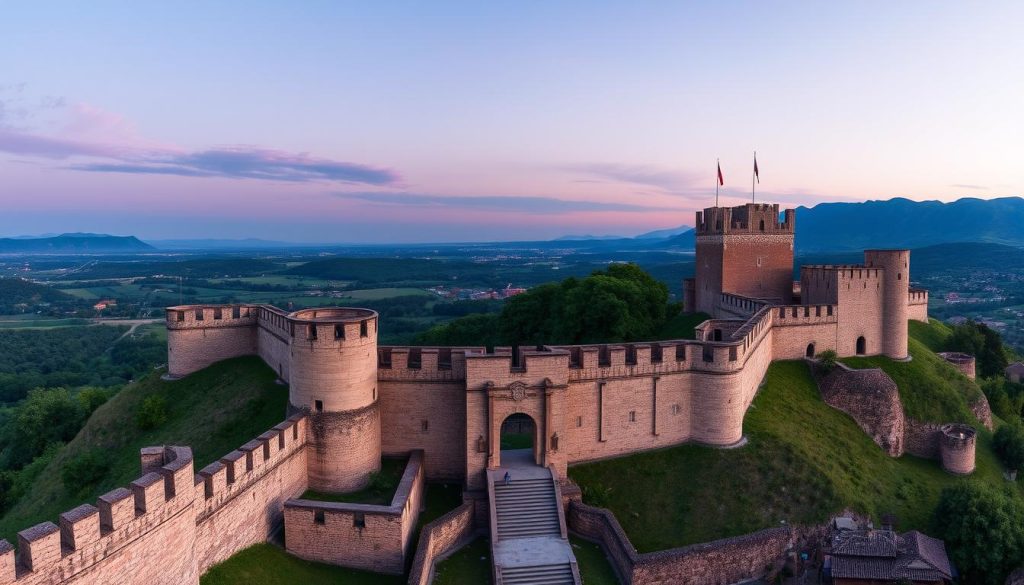
Exploring medieval architecture reveals its military and cultural sides. It shows how strongholds became symbols of power and creativity.
Key Locations for Fortress Exploration in the United States
Many sites across the United States let fans explore fortresses. These places show off military history and architectural progress. Visiting these strongholds lets you dive into the nation’s past and see their importance.
Popular Military History Sites
Some places stand out for their military history. They offer experiences you won’t forget. Here are a few:
- Fort McHenry in Baltimore, Maryland, known for its role in the War of 1812.
- Castillo de San Marcos in St. Augustine, Florida, showcasing Spanish colonial military architecture.
- Fort Sumter in South Carolina, a pivotal point in the American Civil War.
Recommended Stronghold Visits across the Country
Every stronghold visit teaches you about military strategies. Here are some top spots:
- Boston National Historical Park, with 18th-century fortifications.
- Fort Ticonderoga in New York, famous for the Revolutionary War.
- Fort Point in San Francisco, with views of the Golden Gate Bridge and military history.
The Evolution of Defensive Structures Through Time
The history of defensive structures shows a big change over time. These structures have evolved with warfare and technology. This journey helps us see how military needs shaped architecture, leading to today’s fortifications.
Transitions from Medieval to Modern Fortifications
Medieval defenses were mainly stone walls, meant to block bladed weapons and small attacks. But gunpowder changed everything in the 15th century. Now, bricks and stone were used together for stronger walls.
Bastions became key in military design. They allowed for better defense against attackers.
Technological Advancements in Defense
Warfare and defense technology have both grown. New materials like steel-reinforced concrete and advanced missiles have changed old fortifications. Today’s defenses include underground bunkers and electronic watch systems.
These updates show the ongoing need to keep up with new threats. They help us stay safe in a changing world.
Distinctive Designs of Castle Fortifications
Exploring castle fortifications shows a rich history of architectural changes. These changes reflect the evolving needs of military defense. From Europe’s grand structures to America’s innovative designs, each has unique features shaped by geography, military needs, and culture.
Examining European Castle Fortifications
European castles have diverse designs. They often feature thick walls, towers, and bastions for defense. The design choices were influenced by the region’s geography:
- Moats: Many castles had water-filled moats to block attackers.
- Drawbridges: These controlled access, helping defenders manage entry.
- Turrets: Elevated structures allowed guards to watch the area.
These designs not only met military needs but also showed artistic trends of the time. This resulted in structures that were both strong and beautiful.
Unique American Fortification Designs
American fortifications adapted European styles to local conditions and tactics. Here are some key features:
- Earthworks: American forts used soil and earth walls, effective against cannons.
- Log Structures: Early forts used logs, reflecting local resources and quick construction needs.
- Star Forts: Unique to America, these designs offered better defense against artillery with angled bastions.
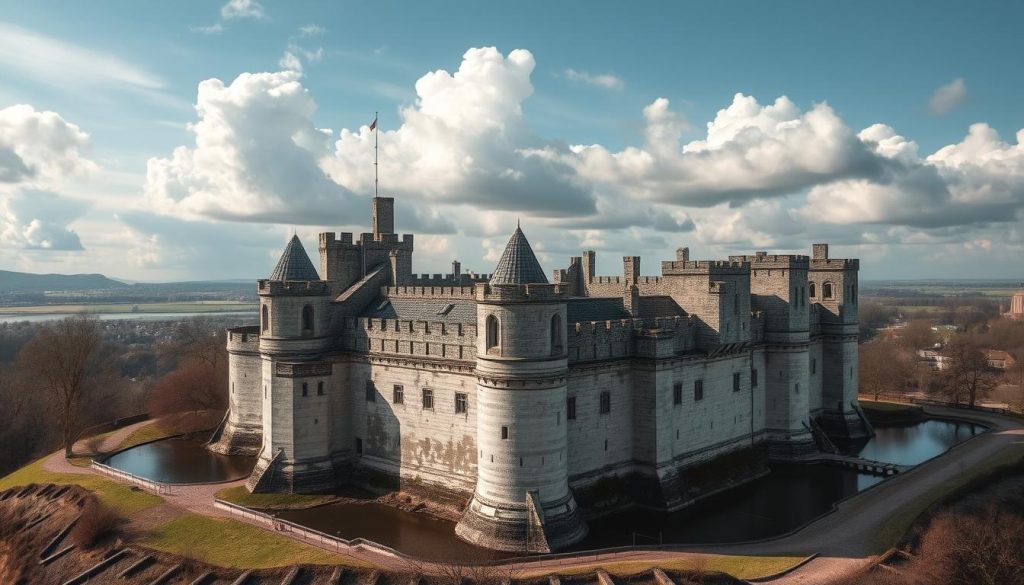
Both European and American fortifications show the creativity and flexibility needed in military architecture. By looking at these features, we understand how local environments influenced defensive strategies across continents.
| Feature | European Castle Fortifications | American Fortification Designs |
|---|---|---|
| Materials Used | Stone, brick | Wood, earth |
| Primary Defensive Mechanism | Thick walls, moats | Earthen walls, star shapes |
| Access Control | Drawbridges, portcullises | Open gates, lookout points |
| Design Purpose | Military, residential | Military, strategic |
This detailed look shows the variety in castle fortifications. It highlights how European and American designs reflect their unique cultural and strategic goals.
Visiting Historical Bastion Sites
Exploring historical bastions gives us a peek into the past’s military architecture and strategies. When planning your visit, keep these tips in mind. They will make your experience better and help you understand these sites more.
Essential Tips for Bastion Sightseeing
Make the most of your time at historical bastions. Here are some helpful tips for a great visit:
- Research the bastion’s history before you go. This will help you appreciate it more.
- Visit during less busy times for a more personal experience.
- Join guided tours for deeper insights and knowledge.
- Bring a camera to capture the amazing views and details.
What to Look for While Exploring
While exploring, look for details that show their historical importance:
- Architectural elements: Find unique designs that show military strategies.
- Defensive structures: Look for walls and fortifications to see their protection.
- Historical artifacts: Search for displays of items used back then.
- Interpretive signs: Read these for more about the bastion’s military history.
Engaging with these elements will make your visit richer. It will help you connect with the historical significance of these sites. Each bastion has its own story from the past.
Preservation and Restoration of Fortifications
Keeping fortifications safe for now and later is very important. These sites connect us to the past, showing us military tactics, building skills, and culture. When you see these structures, you understand why they must be kept safe.
They remind us of history and offer learning chances. This is why they are so valuable.
The Importance of Maintaining Historical Sites
Keeping these sites in good shape is key. They face problems like weather damage and city growth. Each one needs special care and methods to fix it.
By saving fortifications, we keep our history alive. This also helps tourism and learning about military history.
Efforts to Preserve Military History
Groups and local governments are working hard to save these sites. They do things like:
- Starting fundraising to get money for repairs
- Working with history groups to teach and share knowledge
- Using new tech to help keep things preserved
By helping these efforts, you help keep military history alive. You also help fortifications stay important for learning and culture.
The Symbolism of Fortifications and Bastions
Fortifications and bastions are more than old military structures. They are symbols of cultural identity. These structures reflect the societies that built them, showing their values and dreams.
Cultural Significance Beyond Military Use
For centuries, fortifications have been part of community life. They stand as symbols of resilience and the values of past civilizations. The designs of these structures tell stories of art and craftsmanship.
Each culture added its own touch, making fortifications historical canvases. They show how communities expressed their identity through architecture.
Fortifications as National Heritage Sites
Today, many fortifications are seen as national treasures. They help keep our collective memory alive. Their preservation brings national pride, connecting us to our past.
Visiting these sites lets us see the cultural stories in their walls. It deepens our understanding of national narratives and identity.
| Fortification Type | Cultural Significance | National Heritage Site Example |
|---|---|---|
| Castle | Represents feudal power and community safety | Castillo de San Marcos, Florida |
| Fortress | Symbol of defense and strategic control | Fort Ticonderoga, New York |
| City Walls | Indicate growth and resilience of urban life | City Walls of Dubrovnik, Croatia |
| Bastion | Embodiment of military innovation and safety | Fortified Bastion of Antwerp, Belgium |
Conclusion
Exploring fortifications and bastions beyond main gates gives us a deep look into military history and architecture. These structures tell us about past societies and their defense strategies. Each bastion is not just a defense but also shows the culture and creativity of its time.
These historical sites take us back to when war shaped buildings. By seeing the details of fortifications, we learn about military tactics through the ages. The stories in these walls help us understand how societies faced their challenges.
But your adventure into fortifications and bastions is just starting. There’s so much history to discover. By exploring and learning, we not only grow our understanding of war but also help keep these amazing structures alive. This way, they can continue to inspire and educate future generations.

































